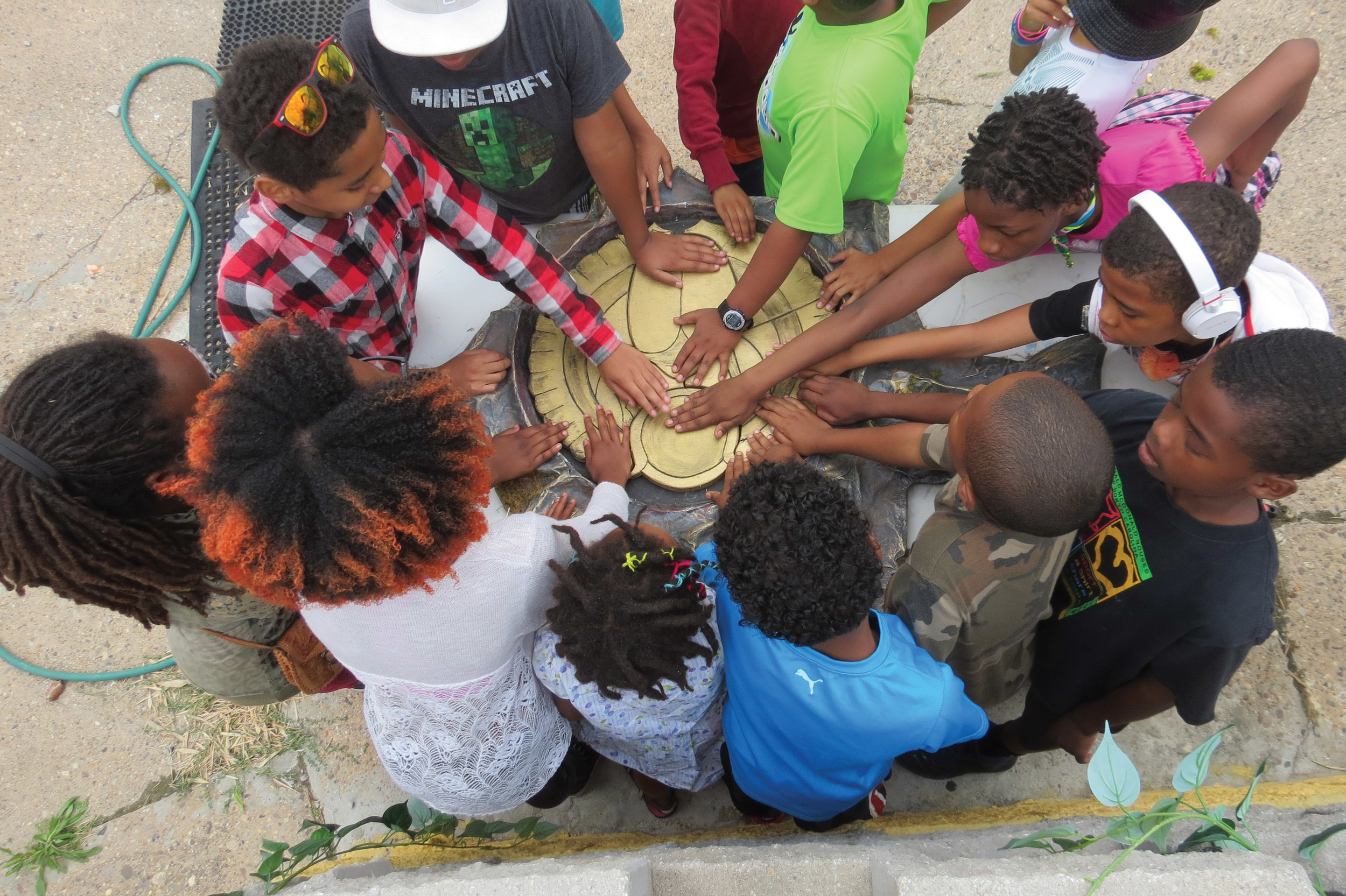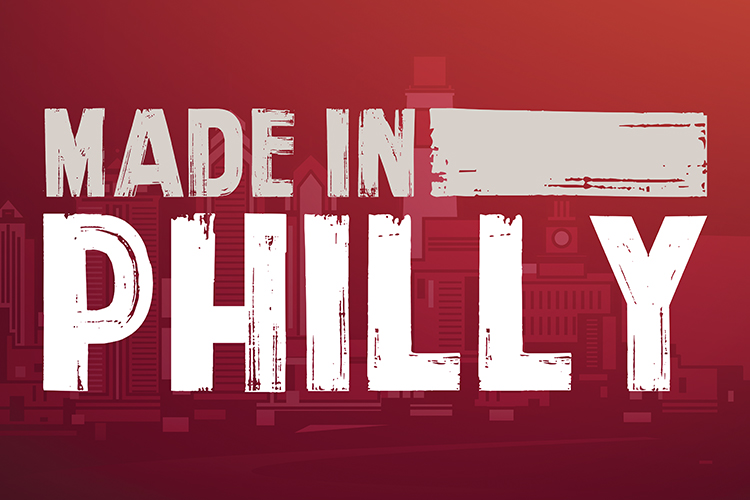Photo courtesy of Hoshea Hart-Rogovin
One Love
by Alex Jones
On an unassuming block of North 52nd Street in West Philadelphia, Malaika Hart and her family have spent more than a decade working toward their vision: an oasis of sustainability and healing where an abandoned lumberyard-turned-short-dumping-ground once stood.
That vision has become One Art Community Center, a sprawling project that has reclaimed abandoned storefronts and lots on a triangle of land within the intersections of 52nd, Harland and Warren streets, just south of Lancaster Avenue.
The center’s stated mission is to “inspire people to creatively heal and express themselves through the varied forms of art”—such as visual or performance art, holistic and martial arts, urban gardening and culinary arts, literature and culture, or even sustainable design.
Regardless of the subject, One Art’s work is about creating opportunities for this community to be together, heal each other, grow and learn.
“‘Each one, teach one’ is a really important concept to incorporate into spaces like this—but really, anywhere,” says Hart. It’s a proverb that originates in the communities of enslaved Africans brought to the United States, most of whom were denied the opportunity to learn to read: It calls on those who did learn to pass on their knowledge to others.
One Art provides its organizers, visiting artists and practitioners with the space and encouragement to do just that, and it provides the neighborhood with a safe space, community hub and learning environment—all on one block.
“Education has been a key to making sustainability work [at One Art], because if just your people know how to do it, it’s not sustainable,” says Hart. “We have to reach everybody.”
At One Art, neighborhood residents—who can attend events free of charge—as well as the community at large, may take regular classes that promote physical fitness, groundedness and empowerment, often with a focus on teachings and traditions of the African diaspora.
“[These classes are] geared toward our community, so someone’s not coming in and being the only student of color in a martial arts class—they’re learning African martial arts,” says Hart.
Vita Saana, which was developed in Philadelphia in the 1970s, places a focus on self-defense and close-quarters combat. The origins of capoiera, a Brazilian martial art, can be traced to communities of Africans enslaved by the Portuguese in the 16th century. And Kemetic yoga is based on body movement, breathing and meditation practices traced to ancient Egypt.
“[Students are] able to connect with their roots and culture, which is really empowering, and the [kind of] empowerment that is really needed right now, especially for our youth,” says Hart.
Meet Hart in person—a beaming, enthusiastic, calming presence—and you’ll understand how she was able to get City Hall to drop fines against her when she was cited for keeping a quiet flock of hens on the urban farm that comprises about half of One Art’s footprint. Raised in a family of activists—“before I could walk, we were marching”—Hart also holds a master’s degree in multicultural education, and she has carried on the work of her late husband, Benjamin Reid, who began work on the project, then called Wall Street International, in 2001.
“The first thing was cleanup,” says Hart, “and then it was just this organic manifestation of this bigger vision that was bigger than any one person and [is] still bigger than any one person that’s on our team.”
The center grew organically as time and money allowed; visiting artists and fellow advocates left their mark, planting fruit trees and adding murals (or, in one case, a permanently parked psychedelic school bus).
“We have a lot of partnerships, because we’ve done everything thus far without any funding,” Hart explains. ”It’s been challenging, it’s been a slow-growing period, but we feel like it’s helped us to really establish strong roots.”
That slow, organic growth has shaped not just the services and opportunities it provides to an underserved community, but also the shape and spaces of the center.
Beyond the bamboo-lined cement courtyard that serves as an entryway from 52nd Street, the interior of One Art is made up of a maze of rooms small and large: artist workshops, social and performance spaces that evoke an old-school, secret nightclub vibe, a recording studio, a soon-to-open café, an art gallery and a healing center.
The neighborhood’s state representative, Vanessa Lowery Brown, even rents office space in one of the buildings on One Art’s property; it helps to connect residents with the center’s work and raise awareness about its offerings.
“Every day there [are] lots of people that come through here and are getting services, getting assistance with a number of things,” Hart says, “and they then [say,] ‘Oh, I didn’t know that you have martial arts here, I’ve been wanting to get my son into [that].’”
Hart is particularly proud of the healing center, which is rented by a practitioner certified in several different kinds of massage therapy. In addition to massage clients, the space hosts Healing of the Nations, a regular event held on the last Sunday of each month that includes lectures by practitioners as well as healthy vegan meals. A fair-style setup allows attendees to connect with diverse healers and learn about different practices. An apothecary-style shop in one area offers herbal preparations and handmade body care products for sale.
“We love when people are like, ‘Oh, I’ve never had a massage before,’ and they’re coming in on one of our community days and they can get a free massage,” says Hart. “Especially with our elders, sometimes this is the first time that they’ve ever experienced things like that. That’s one of the joys [of operating this space], allowing people to experience these types of healing that they were not open to, maybe, because they didn’t even know about it.”
And the healing extends to the outdoors. Behind One Art’s buildings, there’s ample space and a stage for performances, plus the foundation of what Hart hopes will be the city’s first Earthship, a 100 percent sustainable structure complete with greenhouse and bathrooms. Tidily stacked bags of glass bottles and aluminum cans are also stored here, waiting to become bottle bricks that Hart’s current husband makes for building and decorating projects.
At workshops, students learn to make these bricks; the bottoms of the bottles appear in a colorful heart motif on indoor and outdoor walls and surfaces around the center.
“We want to share these skills, we want to give people something to go home with,” says Hart. “Because the more we can spread the information, the more powerful it is.”
Beyond the outdoor performance space is the farm, where chickens roost, fruit trees flourish and communal garden beds teem with organically grown produce in warm months. Here, One Art hosts student groups from neighborhood children to nearby university sustainability programs, teaching skills such as how to care for chickens and the art of raised-bed gardening.
“I really like when the colleges come out, because a lot of those students are in their intellectual world, and this is like, ‘Oh no, this is real,’” Hart says. “Sustainability is real and it’s happening right here in this city.”
While Hart sees the gradually progressing, organic growth of One Art’s spaces and practices as a natural way to build a strong and sustainable foundation for the center and its work, she has a few reasons to be particularly excited for the 2017 season.
Pending approval of building permits, she hopes the Earthship will be finished in the near future. An integral part of the outdoor kitchen, the cob oven (made from affordable materials like clay, sand, bricks and s
traw), is scheduled to be completed this year. Hart plans to get the One Art Gallery & Cafe up and running. A Philadelphia outpost of the Patch Adams Free Clinic is slated to be built on an area of the property, as is the first tiny house in a project designed to provide affordable, sustainable housing to homeless community members.
Oh, and one more thing: After 15 years without funding, One Art has secured nonprofit status, a prerequisite to apply for grants to fund its programming.
“We’re like, ‘Oh wow, if we could do this with no money, imagine what’s gonna happen [now],’” Hart says.
Grant funding might give the One Art team the resources to enhance the ways they promote sustainability while serving their community—but, as Hart points out, getting this far without it has proven that their vision could be lasting, shaped by their community and like-minded partners, and truly sustainable.
“I think we’re ready—we have our foundation,” Hart says. “The importance of having a strong foundation is that when the winds blow or things are pulling you in this direction or that direction, you’re still firm.”



